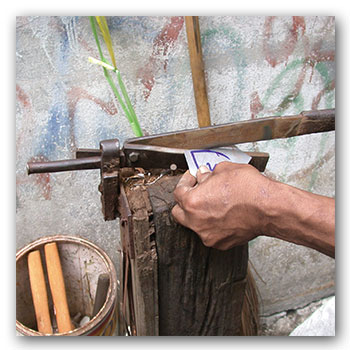Thai Chaser Tool Tricks
3 Minute Read
I was recently in Chiang Mai, a city in northern Thailand, where I spent a month visiting silversmiths and chasers to document their work. The city is teeming with chasers, and there are whole temples covered in metalwork.
The chasers work mostly in aluminum for cost reasons, although they sometimes work in silver. The average wage here is about $8-12 a day, and so tools that Western goldsmiths would take for granted are a serious expense to a Thai jeweler.
Limited tooling is normal, and the tools these chasers do have are often made from all kinds of things. I've highlighted below several examples of how these Thai chasers have solved their tool problems, and I think they're a great reminder to us that being smart can save you money while letting you keep working even when you don't have the right tool on hand.
Homemade Snips
In case you ever need snips and don't have them these homemade ones are great. Made just by connecting two pieces of thick sheet steel together with a bolt and nut, they work well for short cuts. I have seen versions of this in German and British workshops as well. It's nice to know that it is so easy to make a pair of snips.
Long-Handled Snips
Everyone knows that the more leverage you have the easier it is to use cutting tools for thicker metal. I came across a pair of snips at a chaser's workshop with welded-on extension arms. An excellent addition to the tool, the arms offer significant added strength to the user. I also found similar long-handled snips in a Bangkok metal refinery.
As shown above, they had been welded to mounting plates that attach them to a board. A hole had been drilled in one jaw to allow a threaded bolt to be attached, a nut holding it in place. Then a steel disc had a hole drilled in it, and a nut welded over the hole, so that it could be turned onto the bolt. This produces an adjustable stop plate that can quickly be set to different distances depending on the length of the wire or strip that you want to repeatedly and accurately cut. I had found the same solution myself years ago for a production snipping problem.
Planishing Hammers
When the steel to make a hammer costs more than a day's wage, you find ways to reduce the cost. An older style Thai planishing hammer can be made by force-fitting a steel cup end onto the carved peg of a wooden hammer handle. This means significantly less steel is used, which keeps the cost down, and it also makes for an extremely light, responsive wooden hammer that gives great control for fine planishing and finishing.
Dividers
At Direk Sintegarn's workshop I noticed a great pair of dividers for scribing a circle. They were heavy, solid, and well made. I told them how nice they were and amid laughter was shown what they were made from—a broken pair of end cutters. They had simply ground off the cutter end, ground and tapered the handles, and then hit the rivet a little tighter to make the dividers.
Valve Stem Tools
In the third world, from Mexico to Asia, the valve stem from a car's engine is the preferred steel from which to make chasing tools and punches. In Thailand, valve stems are valued highly, and steel types are often known not by their designation numbers, but by what part of the car they are from and what kind of work that steel is good for.
The award-winning Journal is published monthly by MJSA, the trade association for professional jewelry makers, designers, and related suppliers. It offers design ideas, fabrication and production techniques, bench tips, business and marketing insights, and trend and technology updates—the information crucial for business success. “More than other publications, MJSA Journal is oriented toward people like me: those trying to earn a living by designing and making jewelry,” says Jim Binnion of James Binnion Metal Arts.
Click here to read our latest articles
Click here to get a FREE four-month trial subscription.
You assume all responsibility and risk for the use of the safety resources available on or through this web page. The International Gem Society LLC does not assume any liability for the materials, information and opinions provided on, or available through, this web page. No advice or information provided by this website shall create any warranty. Reliance on such advice, information or the content of this web page is solely at your own risk, including without limitation any safety guidelines, resources or precautions, or any other information related to safety that may be available on or through this web page. The International Gem Society LLC disclaims any liability for injury, death or damages resulting from the use thereof.
Charles Lewton-Brain
Master goldsmith Charles Lewton-Brain trained, studied and worked in Germany, Canada and the United States to learn the skills he uses. Charles Lewton-Brain is one of the original creators of Ganoksin.
The All-In-One Jewelry Making Solution At Your Fingertips
When you join the Ganoksin community, you get the tools you need to take your work to the next level.
Trusted Jewelry Making Information & Techniques
Sign up to receive the latest articles, techniques, and inspirations with our free newsletter.
